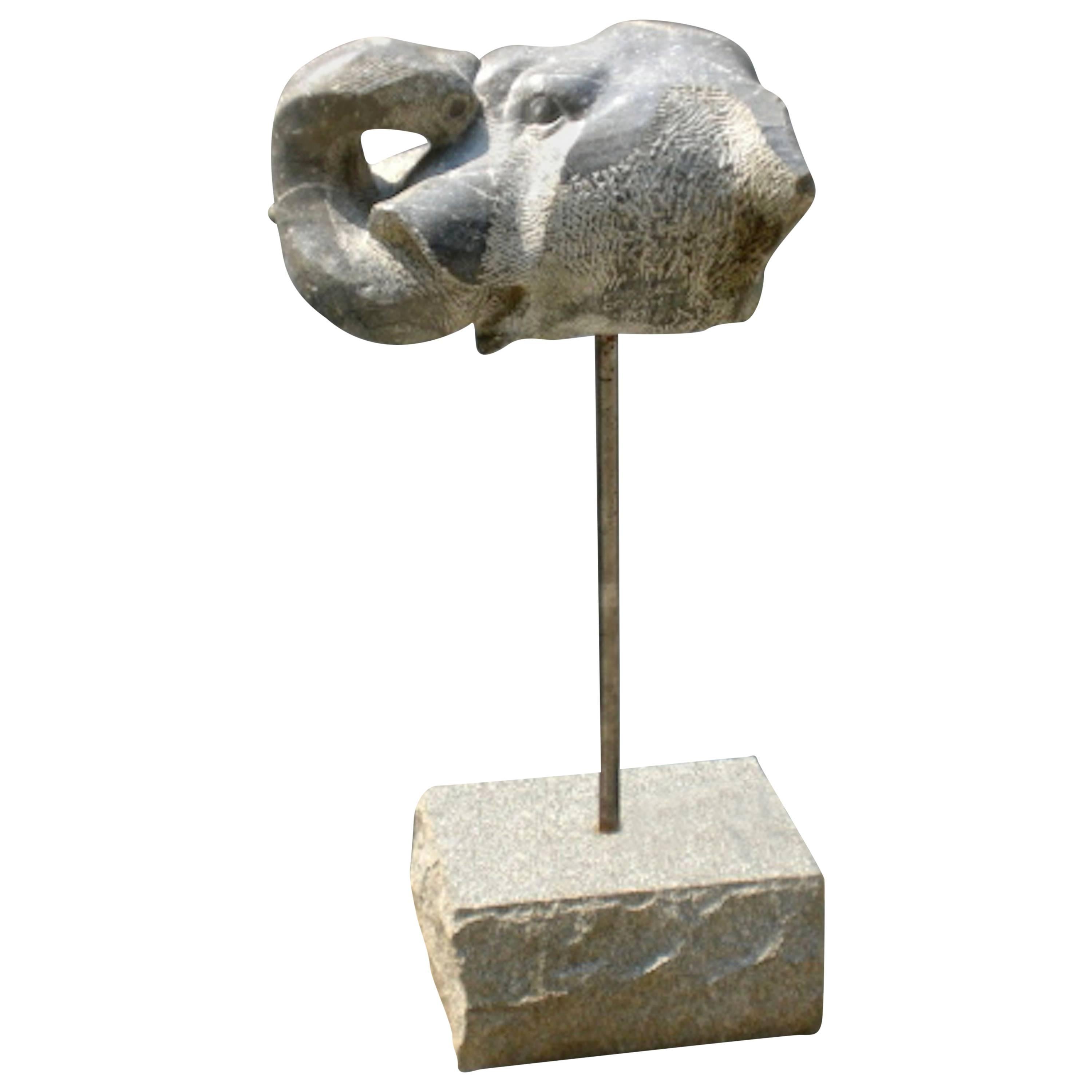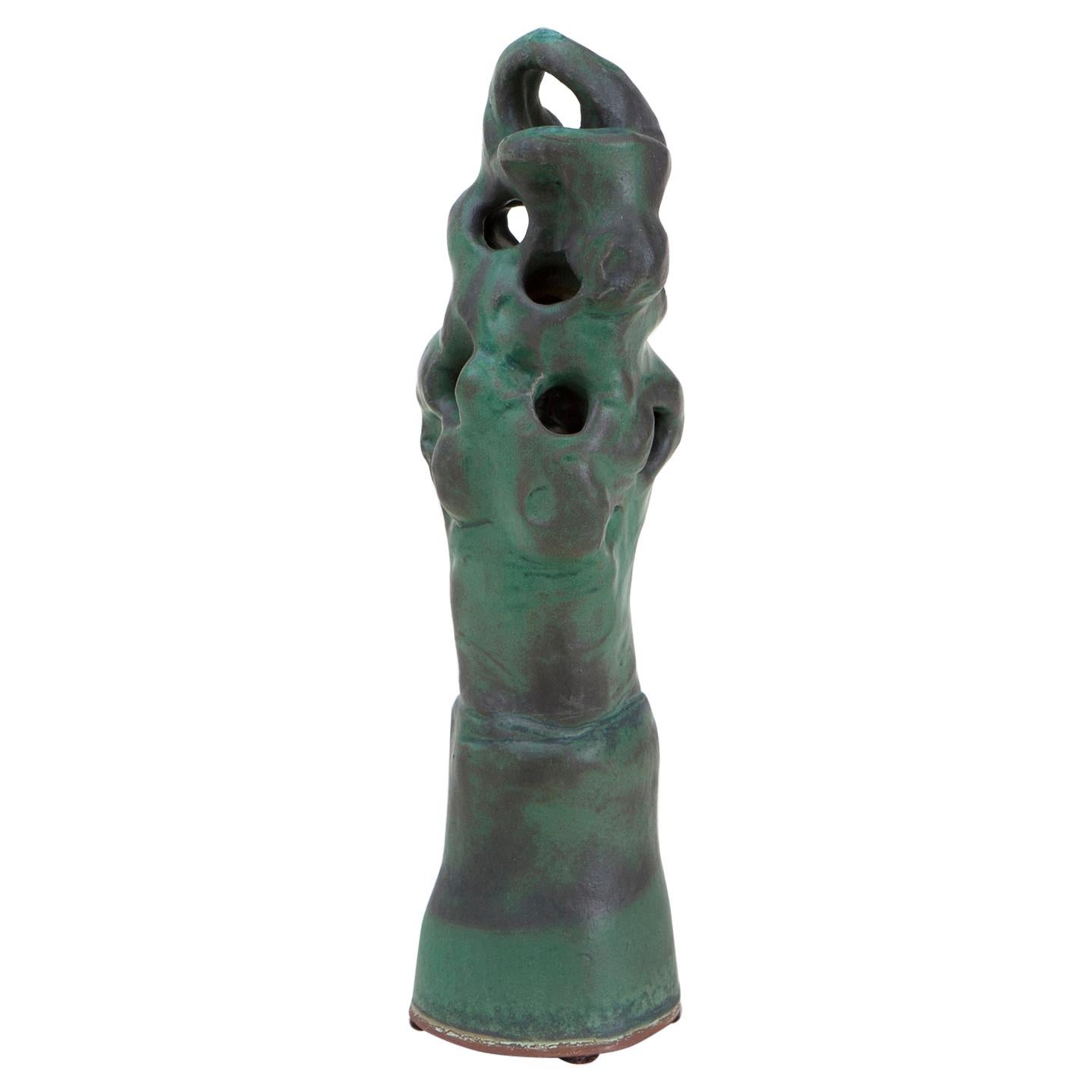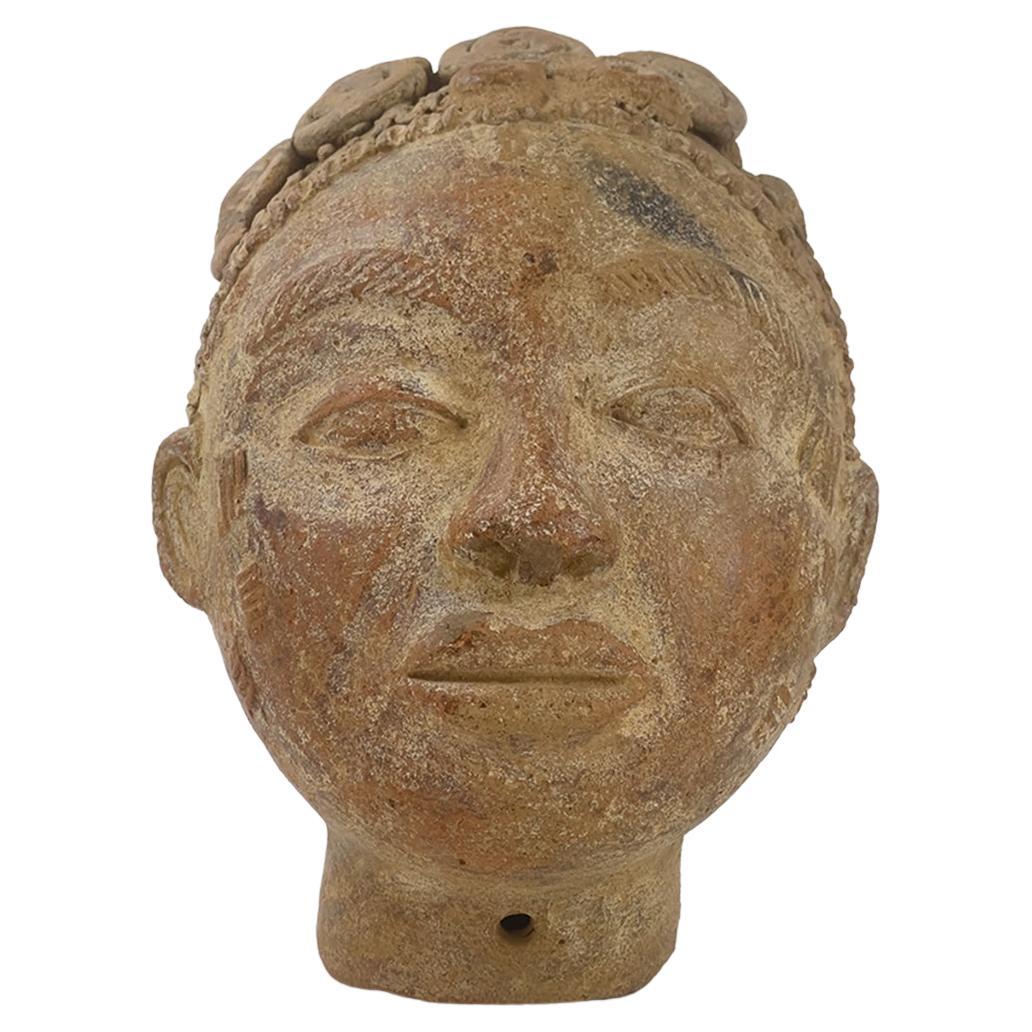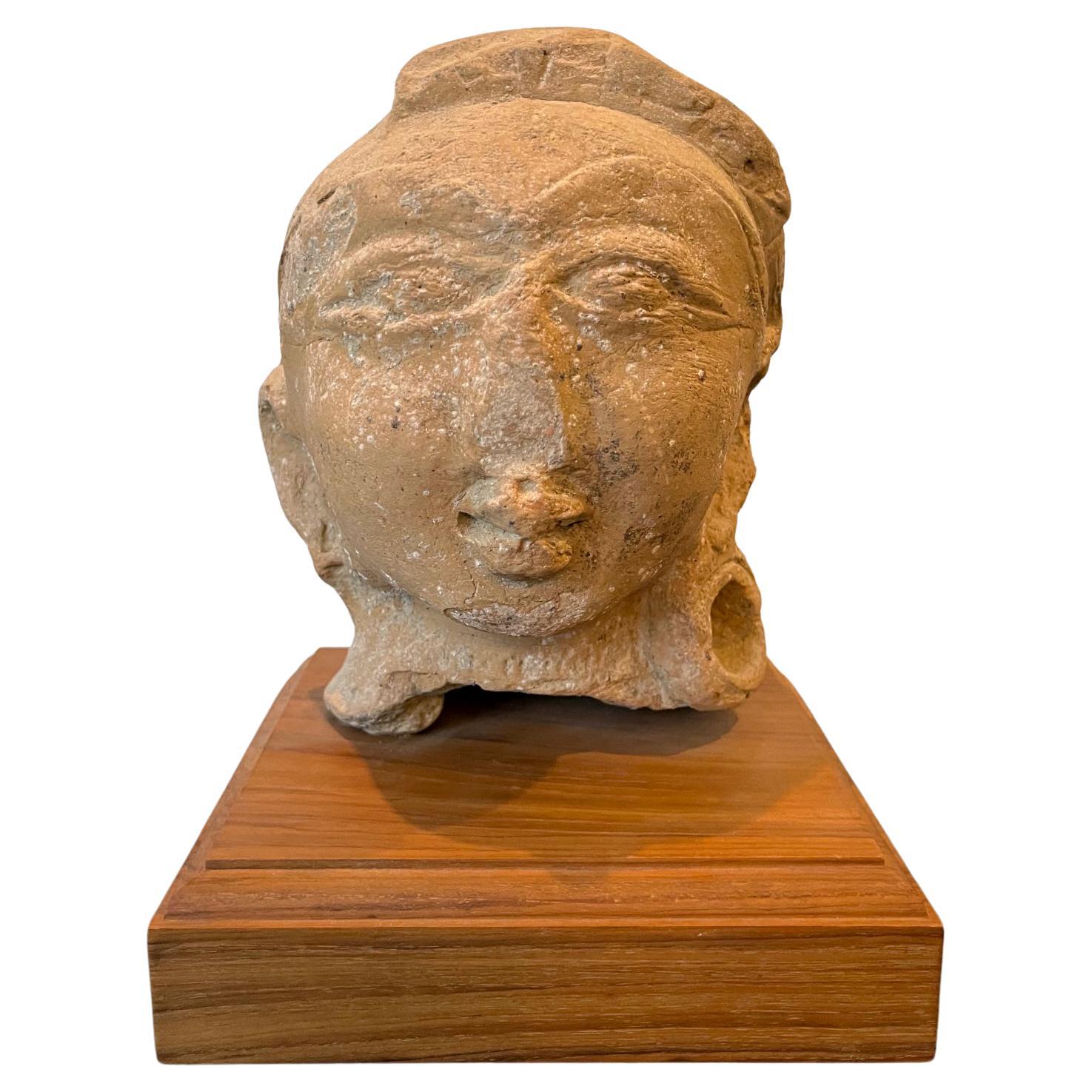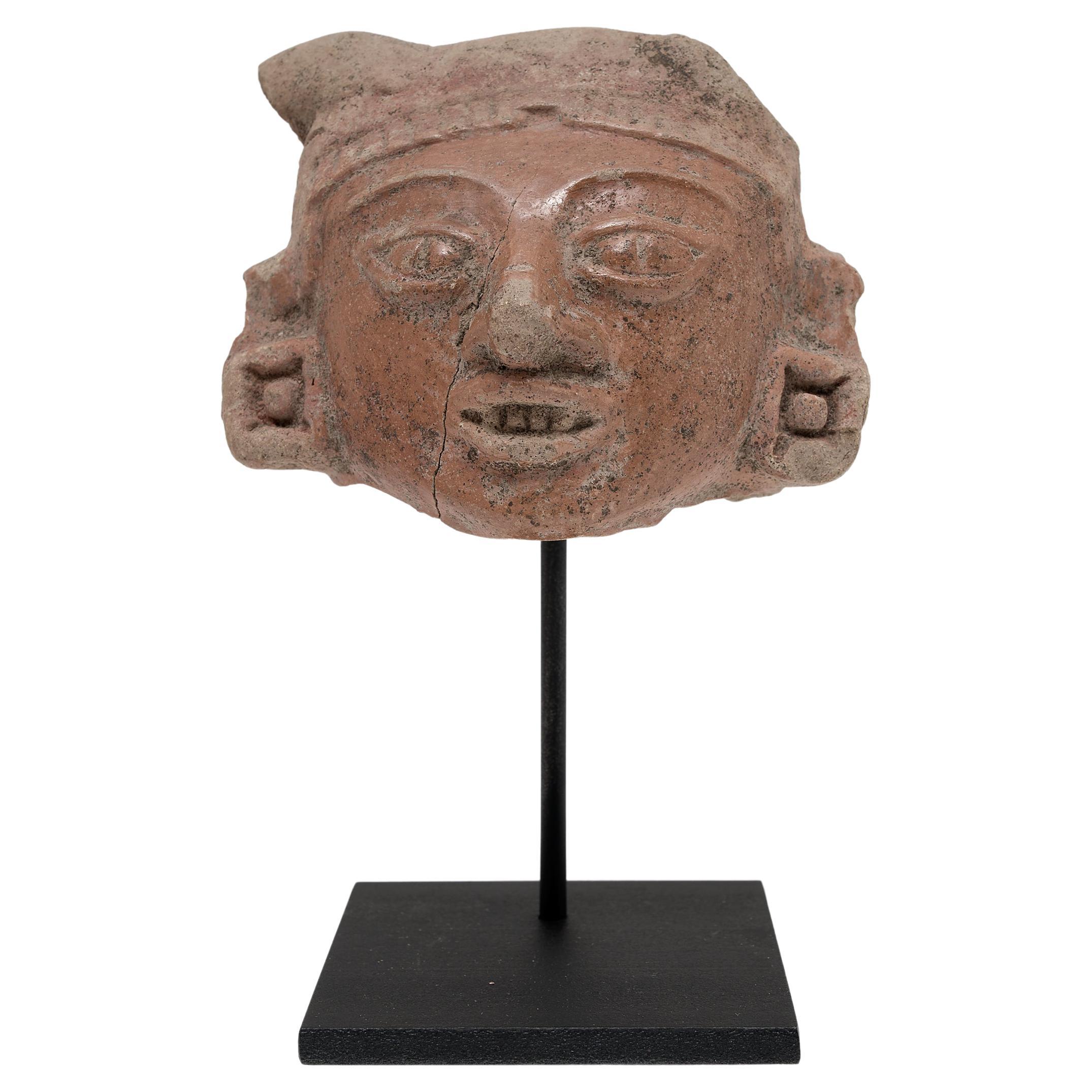Want more images or videos?
Request additional images or videos from the seller
1 of 15
Judy Brady Sculpted Ceramic Head
About the Item
The UNTITLED portrait sculpture has a quiet yet powerful and commanding aura. The viewer cannot be around or near it without feeling its presence. It has a very classical approach in the large straight bridge of the nose and the head of curly hair that is reminiscent of ancient Roman busts. The face is not, however, Classical in that the nose is a bit twisted and one eye is smaller than the other. There is a very soulful look on the face enhanced by the downcast eyes and raised eyebrows. A hint of Giacometti's famous walking figures rests in its large size and tall lean look despite the fact that Giacometti had smaller heads in order to suggest great visual distancing and isolation from the viewer whereas this sculpture absorbs and embraces the viewer.
- Dimensions:Height: 32 in (81.28 cm)Width: 15 in (38.1 cm)Depth: 10 in (25.4 cm)
- Style:Expressionist (In the Style Of)
- Materials and Techniques:
- Place of Origin:
- Period:
- Date of Manufacture:1970
- Condition:
- Seller Location:Bloomfield Hills, MI
- Reference Number:1stDibs: LU7781233542992
About the Seller
5.0
Gold Seller
These expertly vetted sellers are highly rated and consistently exceed customer expectations.
1stDibs seller since 2022
11 sales on 1stDibs
Typical response time: 1 hour
- ShippingRetrieving quote...Ships From: Detroit, MI
- Return PolicyA return for this item may be initiated within 14 days of delivery.
More From This SellerView All
- Robert Bielat Sculpture Cast Bi-Metal Stone Wood "TRUE EAST"Located in Bloomfield Hills, MISALE ONE WEEK ONLY "Robert Bielat was an artist’s artist, a sobriquet applied to those whose work is brilliant but idiosyncratic, deeply compelling in a way that is obvious to those who can see it, but not necessarily so to the market or to the arbiters...Category
21st Century and Contemporary American Expressionist Abstract Sculptures
MaterialsStone, Cast Stone, Metal, Aluminum
- Robert Sestok "Cass Corridor Artist" Detroit Abstract Welded SteelBy Robert SestokLocated in Bloomfield Hills, MIThe "Untitled" abstract sculpture by Robert Sestok has a very deliberate aura of strength in its columnar shape. Upon closer inspection details emerge su...Category
Vintage 1980s American Expressionist Abstract Sculptures
MaterialsSteel
- Monumental Harry Bertoia Silver Necklace, Bertoia Catalogue Raisonne D.JE.49By Harry BertoiaLocated in Bloomfield Hills, MIWEARABLE ART AN IMPORTANT DESIGN FOR A NECKLACE The necklace is unique and extraordinary. Because of its specific design elements it lays beautifully and comfortably on any body structure. This piece comes from a private collection. Provenance will accompany the piece. It has been authenticated by Val Bertoia and is listed in the Harry Bertoia Foundation Catalogue Raisonne # D.JE.49 having been authenticated as a Harry Bertoia piece. REPLY FROM CHRISTIE'S: "Dear Charles, thank you for contacting Christie's. I am absolutely stunned to see the necklace by Harry Bertoia you have submitted for feedback from us, and I would love to speak with you about the work at your earliest convenience. I am a great fan and a known expert in the work of Harry Bertoia, and I have handled over 600 of his sculptures, jewelry and art over the last 22 years. I have never seen a better piece of his jewelry, and it stands as one of the greatest objects in any category that he made. Michael Jefferson Senior Vice President International Senior Specialist Design" The following is from Beverly H. Twitchell, PhD, author of Bertoia: The Metalworker, London: Phaidon, 2019. She provides a very informative critique of Bertoia and his jewelry. Wearable Art an Important Design for a Necklace “Before Harry Bertoia enrolled at the Cranbrook Academy of Art in 1937 he had already mastered traditional jewelers’ techniques, but his engagement with Modernism led him to invent and use more direct methods. Instead of precious metals and gems, Bertoia made jewelry that appealed through its design, craftsmanship and the nature of its materials. That approach would make Bertoia a direct predecessor of the American Studio Crafts movement. So complex and cumulative are human perception and memory that we often do not know from where our own ideas come and without firm evidence, it is impossible to think we can establish the origins of an artist’s ideas. While his jewelry is entirely modern, chokers with multiple small pendants had come from ancient Mediterranean cultures: Mesopotamia, Egypt, Greece and Italy, even from Europe and America at the turn of the last century. Did Bertoia see works in books, journals or at the Detroit Institute of Arts that resonated with him or did he invent this on his own, as he would so many other forms? Bertoia found inspiration in nature from an early age on a small farm in Italy and later in Cranbrook’s woods, on the beaches of southern California and in the fields near his home in eastern Pennsylvania where he lived after 1950. The fluidity and motion of the his jewelry characterize much of his art. In that spirit, too, he made jewelry that suited human anatomy and was animated by its wearer’s movement. Bertoia had the instincts of an engineer, as the intricacy of the present lot’s clasp and overall construction of the jewelry demonstrates. Large jewelry by Bertoia is very rare. A delight to the eye, and like all of Bertoia’s work it is timeless. Bertoia had the instincts of an engineer, as the intricacy of the present lot's clasp and the overall construction of this piece demonstrate. Closed, the necklace sits on a table in a surprisingly conical shape, but it is so flexible that it conforms to its wearer from her neck nearly to her shoulders. Each handmade section is riveted to its neighbors, allowing it to adjust to the body while the pendants curve in many directions: one fits the left clavicle so precisely that Bertoia likely tried it on Brigitta Valentiner, who became his wife in 1943. Other pendants face toward or away from each other, bending up or down. Each element has been hammered into multiple curves and worked in Bertoia’s hands. Large jewelry by Bertoia is very rare. A delight to the eye, this necklace no doubt caused a sensation in its day as it might at the 2022 Met Ball in ours, for like all of Harry Bertoia’s work, it is timeless.” Harry Bertoia (1915 – 1978) was an Italian-born American artist, jewelry creator and modern furniture designer. He was born in San Lorenzo d...Category
Vintage 1940s American Abstract Sculptures
MaterialsSterling Silver
- Heinrich & Co. Porcelain Figurine "EAGLE OWL"By Heinrich & Co. 1Located in Bloomfield Hills, MI"Eagle Owl" is a fine porcelain figurine depicting an owl about to depart from a branch to attack its prey. The details are exquisite and set off by 24 karat gold. It is produced by ...Category
Mid-20th Century German Animal Sculptures
MaterialsGold
- Tony Rosenthal Abstract Sculpture Blackened Steel Red BlushesBy Tony RosenthalLocated in Bloomfield Hills, MISALE ONE WEEK ONLY UNTITLED is an abstract blackened steel sculpture that has a continuous lively movement. The positioning of the heavy metal is suggestive of dance. There are similarities to the sculptors, Robert Sestok and Tony Smith, who both worked in bronze and painted steel with similar cut out pieces and abstract designs. Untitled has a joyous aura and its small size makes it a charming intimate piece. It might have been a maquette for a much larger piece. The design works in this 14" height as it would in a 14' height. There is a Letter of Certification that will accompany the sculpture. Tony Rosenthal (1914 - 2009) is best known for creating a staggering list of monumental public art sculptures. For over seven decades Tony Rosenthal created an arc of sculpture in a variety of sizes, styles and media, including wood, steel, bronze, brass, cement and aluminum. Every day millions see, enjoy and interact with art created by Rosenthal in cities around the world. In New York City alone, five Rosenthal public art sculptures have been beloved and visible 24/7 for over four decades, yet Rosenthal is not a household name. Art dealer Joseph K. Levene, told The New York Times, Tony Rosenthal "reminds me of a character actor. You know the face but not the name. With him, you know the art." Tony Rosenthal dedicated his life to creating art and actively created sculpture everyday in his Southampton, New York studio until he passed away at the age of 94, July 28, 2009. At nine Rosenthal learned the fundamentals of carving sculpture when his mother, an opera singer enrolled him in children's classes at the Art Institute of Chicago where he learned how to carve sculptures in soap. In 1936 Rosenthal earned a B.F.A. from the University of Michigan, and in 1952 became the first instructor of sculpture at the University of California, Los Angeles. In 1950 Rosenthal was recipient of the San Francisco Museum of Modern Art’s sculpture award; in 1967, Rosenthal received the outstanding achievement award from the University of Michigan and in 1963 a Ford Foundation Grant. After graduating from the University of Michigan, Rosenthal became studio assistant to Alexander Archipenko, the figurative master sculptor, casting bronzes in exchange for sculpture lessons; at night, Rosenthal taught evening classes in drawing and sculpture. In 1939, Rosenthal enrolled at Cranbrook Academy of Art, studying with Carl Milles, Cranbrook's sculptor in residence; there, Rosenthal forged friendships with husband and wife designers Charles Eames and Ray Eames and the sculptor Lilian Swann Saarinen the wife of architect, Eero Saarinen. Decades later Rosenthal acknowledged his gratitude to Cranbrook by donating his archives to them. The Cranbrook Cube, 1984, a 90" painted aluminum cube is in the Cranbrook Museum collection. In 1942, Rosenthal was drafted into the U.S. Army; while stationed in Paris Rosenthal forged friendships with George Braque, Andre Derain, Le Corbusier and Constantin Brancusi, routinely organizing and accompanying groups of soldiers on studio visits. Through multiple visits to Brancusi's Paris studio, Rosenthal learned to create and forge metal sculpture...Category
Late 20th Century American Modern Abstract Sculptures
MaterialsSteel
- Hutchenreuther Porcelain Figurine Fritz Klee "OWL"By Professor Fritz KleeLocated in Bloomfield Hills, MIThe 24 carat gilded owl was created by Professor Fritz Klee around 1920 for Hutschenreuther Porcelain. This beautifully crafted piece is unusual in that sur...Category
Vintage 1910s German Animal Sculptures
MaterialsGold
You May Also Like
- Sculpted Granite Elephant HeadLocated in Brooklyn, NYBeautiful sculpture art of an elephant with trunk up. "Floating" above a solid granite block. The head is both smoothed and rough in areas. (Please confirm item location - NY or N...Category
20th Century Animal Sculptures
MaterialsMarble
- Modernist Ceramic Sculpture by Judy EngelBy Judy EngelLocated in Brooklyn, NYModernist clay sculpture with organic green glaze by artist Judy Engel of upstate New York.Category
2010s American Brutalist Abstract Sculptures
MaterialsCeramic
- Vintage Ceramic Sculpted OctopusLocated in Miami, FLA colorful vintage sculpture, is in very good condition. Unique and stylish, a wonderful centerpiece or focal point decor. Hand-crafted, ceramic with a glaze finish. This multicolo...Category
20th Century Italian Modern Ceramics
MaterialsCeramic
- Sculpted Clay Head of African WomanLocated in Dallas, TXSculpted clay head of a beautiful African woman. Light sandy brown with rough texture. A hand sculpted piece. Head adorned with a decorative circular pattern...Category
Antique 15th Century and Earlier Figurative Sculptures
MaterialsClay
- Indian Terracotta Sculpted Head Gupta PeriodLocated in Atlanta, GAA fragment of Terracotta statue displayed on wood block stand from ancient Indian continent dated to the Gupta period (4th-6th century). The head of the...Category
Antique 15th Century and Earlier Indian Archaistic Sculptures and Carvings
MaterialsTerracotta, Wood
- Teotihuacan Ceramic Head FragmentLocated in Chicago, ILThis intriguing head fragment was once attached to a bust or full effigy figurine crafted in 400 A.D. Mesoamerica. Earthenware figurines were made in great abundance throughout Teotihuacan's history. After 250 A.D. objects made from clay increased dramatically in Teotihuacan, serving a wide variety of purposes and functions from religious rituals to burial offerings. Figurines like this commemorated important people and events within the city of Teotihuacan and other parts of Mesoamerica, portraying individuals of different rank and status such as soldiers, merchants, bureaucrats, and occasionally divinities. This figure is adorned with an elaborate coiffure or headdress and ear spools...Category
Antique 15th Century and Earlier Mexican Pre-Columbian Figurative Sculpt...
MaterialsCeramic
Recently Viewed
View AllMore Ways To Browse
Louise Brongniart Busts
Bronze Bust Roma
Corkscrew Boy
Angel Bust Plaster
Boy And Girl Bust
Busted Of French King
W Beaupre Chain Mail Bust
Wedgwood Washington Bust
Winston Churchill Jug
Wood African Sculpture Antique Busts
Vintage Phrenology Bust
Vintage Phrenology Head
Greek Tragedy Mask
Marianne Bust
Herm Statue
Marie Antoinette Biscuit
Hermes Bust Statue
Austrian Porcelain Bust
